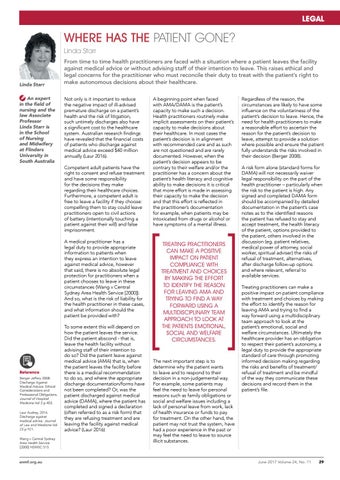LEGAL
WHERE HAS THE PATIENT GONE? Linda Starr
Linda Starr An expert in the field of nursing and the law Associate Professor Linda Starr is in the School of Nursing and Midwifery at Flinders University in South Australia
From time to time health practitioners are faced with a situation where a patient leaves the facility against medical advice or without advising staff of their intention to leave. This raises ethical and legal concerns for the practitioner who must reconcile their duty to treat with the patient’s right to make autonomous decisions about their healthcare. Not only is it important to reduce the negative impact of ill-advised premature discharge on a patient’s health and the risk of litigation, such untimely discharges also have a significant cost to the healthcare system. Australian research findings have revealed that the financial costs of patients who discharge against medical advice exceed $40 million annually (Laur 2016). Competent adult patients have the right to consent and refuse treatment and have some responsibility for the decisions they make regarding their healthcare choices. Furthermore, a competent adult is free to leave a facility if they choose: compelling them to stay could leave practitioners open to civil actions of battery (intentionally touching a patient against their will) and false imprisonment. A medical practitioner has a legal duty to provide appropriate information to patients when they express an intention to leave against medical advice, however that said, there is no absolute legal protection for practitioners when a patient chooses to leave in these circumstances (Wang v Central Sydney Area Health Service [2000]). And so, what is the risk of liability for the health practitioner in these cases, and what information should the patient be provided with?
Reference Berger Jeffery 2008. Discharge Against Medical Advice: Ethical Considerations and Professional Obligations. Journal of Hospital Medicine Vol 3 p 403. Laur Audrey, 2016. Discharge against medical advice. Journal of Law and Medicine Vol 23 p 921. Wang v Central Sydney Area Health Service [2000] NSWSC 515
anmf.org.au
To some extent this will depend on how the patient leaves the service. Did the patient abscond - that is, leave the health facility without advising staff of their intention to do so? Did the patient leave against medical advice (AMA) that is, when the patient leaves the facility before there is a medical recommendation to do so, and where the appropriate discharge documentation/forms have not been completed? Or, was the patient discharged against medical advice (DAMA), where the patient has completed and signed a declaration (often referred to as a risk form) that they are refusing treatment and are leaving the facility against medical advice? (Laur 2016)
A beginning point when faced with AMA/DAMA is the patient’s capacity to make such a decision. Health practitioners routinely make implicit assessments on their patient’s capacity to make decisions about their healthcare. In most cases the patient’s decision is in alignment with recommended care and as such are not questioned and are rarely documented. However, when the patient’s decision appears to be contrary to their welfare and/or the practitioner has a concern about the patient’s health literacy and cognitive ability to make decisions it is critical that more effort is made in assessing their capacity to make the decision and that this effort is reflected in the practitioner’s documentation for example, when patients may be intoxicated from drugs or alcohol or have symptoms of a mental illness.
TREATING PRACTITIONERS CAN MAKE A POSITIVE IMPACT ON PATIENT COMPLIANCE WITH TREATMENT AND CHOICES BY MAKING THE EFFORT TO IDENTIFY THE REASON FOR LEAVING AMA AND TRYING TO FIND A WAY FORWARD USING A MULTIDISCIPLINARY TEAM APPROACH TO LOOK AT THE PATIENTS EMOTIONAL, SOCIAL AND WELFARE CIRCUMSTANCES.
The next important step is to determine why the patient wants to leave and to respond to their decision in a non-judgemental way. For example, some patients may feel the need to leave for personal reasons such as family obligations or social and welfare issues including a lack of personal leave from work, lack of health insurance or funds to pay for treatment. On the other hand, the patient may not trust the system, have had a poor experience in the past or may feel the need to leave to source illicit substances.
Regardless of the reason, the circumstances are likely to have some influence on the voluntariness of the patient’s decision to leave. Hence, the need for health practitioners to make a reasonable effort to ascertain the reason for the patient’s decision to leave, attempt to provide a solution where possible and ensure the patient fully understands the risks involved in their decision (Berger 2008). A risk form alone (standard forms for DAMA) will not necessarily waiver legal responsibility on the part of the health practitioner – particularly when the risk to the patient is high. Any signed and completed DAMA form should be accompanied by detailed documentation in the patient’s case notes as to the identified reasons the patient has refused to stay and accept treatment, the health literacy of the patient, options provided to the patient, others involved in the discussion (eg. patient relatives, medical power of attorney, social worker, spiritual adviser) the risks of refusal of treatment, alternatives, after discharge follow-up options and where relevant, referral to available services. Treating practitioners can make a positive impact on patient compliance with treatment and choices by making the effort to identify the reason for leaving AMA and trying to find a way forward using a multidisciplinary team approach to look at the patient’s emotional, social and welfare circumstances. Ultimately the healthcare provider has an obligation to respect their patient’s autonomy, a legal duty to provide the appropriate standard of care through promoting informed decision making regarding the risks and benefits of treatment/ refusal of treatment and be mindful of the way they communicate these decisions and record them in the patient’s file.
June 2017 Volume 24, No. 11 29
